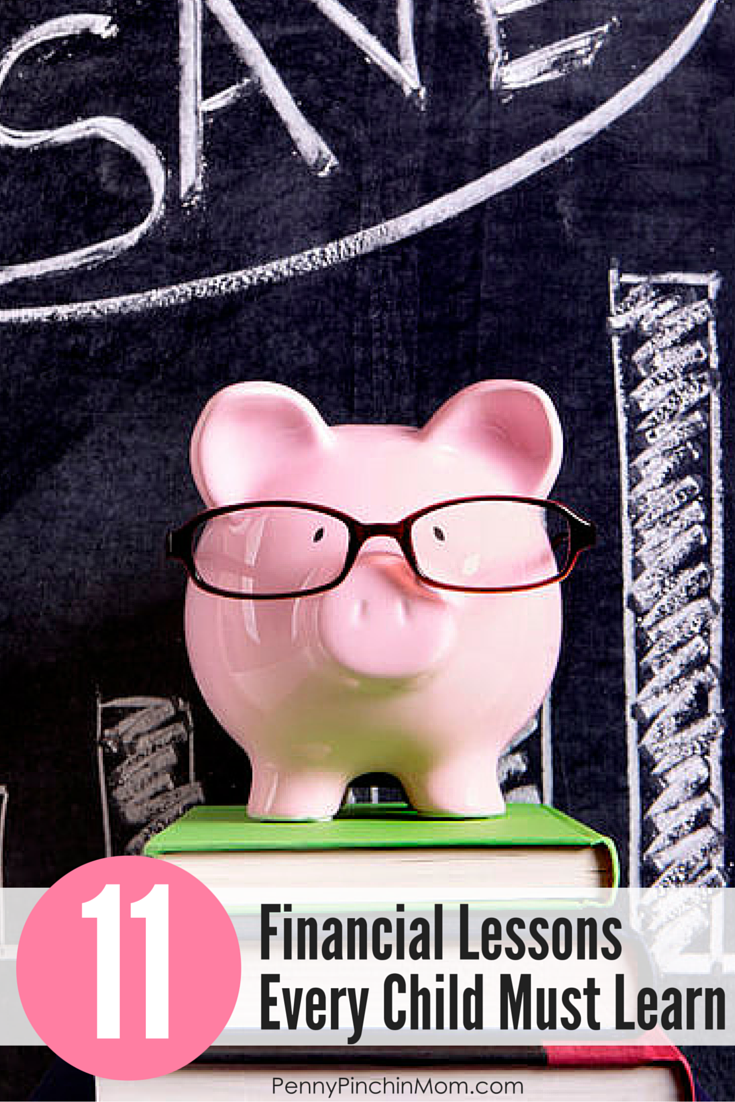Growing up, my parents taught me so many things. I learned how to take care of myself. They taught me how to clean and to cook. I learned about ethics, morals and also a lot about my faith. It is impossible to list all of the things they passed along to me. However, I can mention one thing that they never did — Finances.
I once asked my mom why it was never a discussion and she said that her parents had never really taught her that she and her siblings learned by watching. She said that she was not even aware that this was something that should she should have also taught me. In fact, the only thing she ever taught me about money was how to maintain and balance my checking account.
Unfortunately, I made a lot of money mistakes. I even had to declare bankruptcy. However, I am lucky that I learned from my own mistakes, and now we’ll make sure our children excel in financial literacy. The mistakes I made are ones I never want to see them make.
I thought about what I really should have learned from my parents. My list was much longer than I thought it would be. It helped my husband and me, as we are starting to teach our children about money and what tools they need to learn to use before they leave our home.
WHAT KIDS NEED TO LEARN ABOUT MONEY
1. Budget
If you don’t teach your child anything else, make sure you teach them to budget.
When I moved out on my own, I had a list as to the bills I had to pay — which was anything but an actual budget. I can’t tell you how many times my budget included me robbing Peter to pay Paul. It was my normal but I don’t want the same for my kids.
A well-written budget helps you account for every penny coming into your household. It all needs to be assigned a duty. It includes paying the mortgage and keeping the lights on. A budget should also cover food and clothing. The one thing that you need to make sure you do not forget is to make sure you are also designating money towards savings.
Even at a young age, a child can learn to create and use a budget. It can include simple items such as saving for gifts for siblings. They can learn how to budget for the things they want to do with their friends. And of course, kids need to learn to budget in savings.
It does not need to be in depth, and really should not. The first budget should be straightforward. If they earn $10 a week, have them use a budget to save a percentage, give some away and have the rest for their spending. The sooner you teach your kids budgeting, the more successful they will be when they are on their own.
Read More: Teaching Teens About Saving vs. Spending
2. Credit cards
These can be a blessing and a curse all at the same time. Young people need to learn how to handle credit. They also need to establish a baseline for future purchases. But what is most important is that they use credit wisely.
The truth is that many college students head away from home and get tempted by the lure of the credit card. Spend and have fun right now. You don’t need the cash right now. Pay for it now and pay it off later. Sure, it sounds great, but it is not the right way to handle cards.
Kids should learn that you use a credit card to buy something — but only if you have the money in the bank to cover the cost. The idea is to establish good credit by buying one item and paying for it in full every month. They also need to understand that while it is tempting to hold on to your cash, it is the worst way to manage credit.
It can help to use a credit calculator to show your kids how much that $500 credit line (at a rate of 15%) would cost them should they make only the minimum payment. Seeing the cold hard truth can help drive this fact home.
If you want to help your kids learn how to manage credit, you can try this at home. Get an expired card you have and allow them to “make charges” with you for things they may want to buy at the store. Help them understand how to watch their budget. At the same time, help them track the cash they have on hand so that they can pay it off at the end of the month.
3. Debit Cards (and how cloud works)
In this day and age, most people use plastic to pay for everything. It can be very convenient, but can also lead to trouble – tracking your spending.
Kids have to understand that a debit card does not mean that they can use it to buy anything they want. They need to understand the concept. Teach your child how your bank account and debit work together.
You can teach this in the same general way as you would on how to use a credit card. Give your child their own “debit card” (which can be a piece of paper). When they need things, they can hand you the debit card. Then, you can turn around and tell them to now give you the cash to pay for it. Doing so can help them better understand how this is instant payment.
Read More: How to Teach Your Kids About Debit vs. Credit
4. Emergency fund
Teaching your kids to save money is a lesson you can start at a very young age. Teach your kids by helping them save a certain percentage of every allowance. It has to be in an account that they know they can not touch. They need to know it is there only for an emergency.
It is not even just the savings aspect but helping them understand what an emergency is. An emergency is not that the shoes that they have been wanting are now on sale. It could be that the computer they need for school just bit the dust, and they need to get a new one.
Read More: How to Quickly Build an Emergency Fund
5. Wants vs. needs
As adults, we know when it comes to finances, we first cover our needs. Then, if there is money left over, we can get the wants in our life. Kids need to understand this as well.
As they move into the real world, payday does not mean that you get to go out with your friends on Friday night. They need to make sure the paycheck first covers their expenses. Then, they can go out with friends.
Teach this to your kids by having them make two lists. One will be the things they need to live. The other will be items that are not necessary. You might be surprised at what they include on each one. They will identify the difference between wants and needs.
Use this tool in the store as you add items to your cart by having your child identify the wants and the needs.
Read More: Needs vs. Wants and How to Fit Them Into Your Budget
6. Setting financial goals
We all need to have goals in life. That is what drives us. As adults, we have financial goals. They may be getting out of debt. Your goal may be building your retirement fund. It could even include saving for the dream vacation. Your goals are your own, and so that makes them right for you.
Kids can learn this as well. Have them determine what big ticket item they want to purchase.
For my oldest daughter, it was a tablet. We sat down and helped her with her budget and then the steps she would need to follow to reach her goal. Her plan included additional work to earn more money. She also had to figure out a way spend less of her allowance.
I’m proud to say that it took her some time, but she did reach her goal. The funny thing is that once she had all of that money in her hand, the tablet became less important to her. She worked hard to save her money, and she did not want to part with it. She learned not only how to save, but how something we think we want, is not as important as originally thought.
Read More: How to Set Realistic Financial Goals
7. Stocks
If you have a retirement account of any sort, then you currently own stocks. You may also have some through investment accounts. Kids need to understand stocks and a bit about investing.
The easiest way to explain a stock is to tell kids that when you own stocks, you own a small part of a company. As the company is successful, so will they. However, if the company does poorly and loses money, they too will lose money.
Perhaps this is the time for you and your child to invest together. Have them sit down with you and do some research and then buy stock. You can watch the performance together, through the highs and the lows. With some things in life, the only way to learn is to jump in and make it happen.
Read More: Short-Term Investments You Should Look Into
8. Money and greed
Teaching kids about greed is pretty easy to do (and how I wish some adults would take a repeat and remember this lesson).
The best way to help them understand is by example. Talk about the idea of them keeping all of their toys for themselves and never sharing them with anyone. That is the idea of greed. It is the concept of thinking you need everything and will not share with anyone.
Read More: How to Raise Non-Materialistic Children (In a Materialistic World)
9. Donating (wisely)
Kids need to understand the importance of helping others. Donating does not always mean money. It can be giving away items you no loner need or giving your time to help others.
The sad thing is that there are many groups who would scam your child and take his or her money without thinking twice. While we do not want to discourage our children from donating money, we need them to understand to whom they are giving their money.
The best way for kids to learn this idea is to talk about illnesses, such as cancer or diabetes. Discuss professions who may ask for help. It might include first responders, schools or churches. Talk to them about the way to donate money to that charity. Discuss that the best way is direct to the group itself. They should understand that it is not wise to give money at our door. It is also better to pass on making donations to the person on the phone.
We certainly do not want to scare our children. However, we need to make sure they understand the right way to make any cash donations to any organizations.
10. Understanding debt
Sadly, this is the one area that many adults have had to figure out on their own. It usually ends with terrible results. I include myself as one of them. Of course, I was able to turn things around and no longer have debt hanging over my head. I never want my kids to feel the stress that debt brings to them.
The way that you can help your kids will depend on the age, however, here is one idea for older kids. Have your child come up with something that they want to get. Make sure it costs more than what is in the budget or savings. Ask them how they would pay for that item if they did not have the money. Then, show them how debt feels when you have no money left because you have to give it to everyone else.
Option one will be that you will buy the item. However, every penny they earn for additional work around the house or their allowance will go to you until it they pay you back the amount their item cost. They will get nothing.
When your child realizes he or she will not get any money for ten weeks, he or she might be shocked! Put it all down on paper and even use a calendar. Help them see how long it would be before they got a dime from mom and dad again.
Also, talk to them in debt terms. Rather than saying ” you need to pay me back the money you owe,” you could say “you need to repay your debt to me.” It may sound harsh, but it might be the right tactic to help your child understand.
Kids need to get the idea that there is no such thing as good debt. It does not exist.
11. Taxes
No one likes taxes. However, as an adult, we understand that our taxes help pay for a multitude of things. However, this can be a tough one to explain to children.
The idea that even though the store price says $10 that they have to pay $11 at checkout is hard to understand. They do not get why they have to pay more than what the store shelf shows.
The way that we have explained it to our kids is with complete honesty. We talk about the roads we drive on. Talk about the school bus that picks them up in the morning. Discuss the programs that can help give kids food when Mom and Dad can’t afford it. We’ve explained to them that we always give a little of our money back which in turn, helps others and provides us with things we use every day.
Once kids understand how their city and programs are paid for, it starts to make more sense.
12. Retirement savings
When you are 10, you are thinking only about what you want to do this weekend with your friends. You are certainly not thinking about retirement. However, the reality is that they need to understand this.
As adults, we know that relying on the government to take care of us when retire is not the wisest retirement plan. Who knows if social security will even be around by the time our kids hit retirement age. We have to take charge of our own retirement and plan accordingly.
You’ve already discussed the importance of saving money. Kids understand that this is to pay for things in the future. We also talk about a budget and paying expenses with our paycheck. The way to explain this to kids is by asking them how would they pay for something if they were not working anymore? Who would pay the electric bill? How would they buy food? Help them understand that even though it is still a long way off, they need to save a now so that they can live later on.
Read More: Seven Types of Retirement Accounts
Thre are a lot of lessons to teach your kids and you may (or may not) agree with all of them. However, if we think our schools will do it for us, we are wrong.
While I think financial literacy should be a required course for all high school kids, it is not yet here. That means, it is up to us. As a parent, it is my job to educate my children. I want them to live a happy, well-fulfilled life. I mean, isn’t that what we all want?














